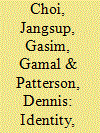| Srl | Item |
| 1 |
ID:
109078


|
|
|
|
|
| Publication |
2011.
|
| Summary/Abstract |
While work on the political behaviour of religious groups in America has shown that, among other things, religious commitment and strong opinions on salient issues can encourage turnout and raise the probability of these groups' members voting in national elections, much less is known about these relationships with respect to Muslim Americans. Using data collected at mosques in 2006 during the holy month of Ramadan, this article maps the turnout patterns of Muslim American respondents and then investigates the factors that explain the political participation of members of this increasingly important religious group. The article focuses on reported turnout in the 2004 presidential election and shows that, more than anything else, strong opinions on salient issues boosted the participation rates of members of this religious group in the election, even when controlling for other factors known to help explain turnout.
|
|
|
|
|
|
|
|
|
|
|
|
|
|
|
|
| 2 |
ID:
090831


|
|
|
|
|
| Publication |
2009.
|
| Summary/Abstract |
The theory of spatial voting has played a large role in the development of important results across many areas of political science. Directly testing the foundational assumptions of spatial voting theory, however, has not been possible with existing data. Using a novel survey design, this article obtains estimates of voter ideology on the same scale as candidate positions. The results of this scaling demonstrate that voters possess meaningful ideologies and, furthermore, that these beliefs are strongly related to the sorts of policy proposals considered in Congress. These ideology estimates are then used to uncover the actual relationships between ideology and vote choice for citizens of various types in the 2004 presidential election. Although the choices of independent voters are shown to be largely consistent with the assumptions of spatial voting theory, the decision rules used by partisans differ strongly from what unbiased spatial voting would imply. Although partisans do converge toward the behavior of independents, and hence toward the assumptions of spatial voting theory, as information levels increase, we see that even highly informed partisans show significant differences from what would be implied by unbiased spatial voting theory.
|
|
|
|
|
|
|
|
|
|
|
|
|
|
|
|